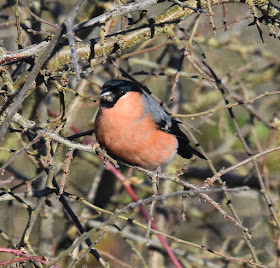 |
| Teal (c) JR |
It was a very “birdy” weekend with change starting to
happen, lots to see and plenty going on. The weather too was better, crisp and
bight on Saturday morning with plenty of winter sunshine and on Sunday a foggy start
gave way to a pleasant bright morning before rain arrived in the afternoon.
 |
| Great Spot and Goldcrest (c) JR |
 |
| Goldies (c) Bark |
Yet again it was impossible not to be impressed by the sheer
numbers of birds present. As before the huge flocks of Golden Plover and
Lapwings were impossible to ignore. Sometimes after they had been flushed, headed
up high and were starting to descend it appeared as if the whole sky was speckled
with birds.
 |
| Golden plover and Lapwings (c) Bark |
At other times we were treated to very low flypasts. When three or
four hundred birds pass no more than fifteen or twenty feet above you the sound
of their wingbeats and the whoosh of the downdraft allows you to really appreciate
just how fast they can go. The Lapwings too were spectacular, as they made a
slower black and white counterpoint to the faster more densely packed plovers.
We even noticed a few Lapwings above the Flood Field starting to perform their
tumbling display flights.
 |
| Wigeon and Teal (c) Bark |
Wigeon and Teal are spread over the whole reserve but are in
the largest concentrations on Big Otmoor, The Flood Field and the big lagoon on
Ashgrave. There were also three Shelduck on Big Otmoor on Saturday and ten or
twelve Pintail. The twenty or so Pochard are still around on the Southern
Lagoon and “Luke” the leuchistic drake is still keeping company with a female
but is now remaining more separate from the rest of the flock.
 |
| "Luke" (c) Bark |
On Sunday morning the fog meant that the distant sounds of
traffic on the A34 and the motorway were all but eradicated and the natural
sounds were clearer and easier to appreciate. At the first screen the metallic
clicks and harsh monosyllabic tacks of the Coots was particularly noticeable as
it echoed around the lagoon. Every so often the sounds would accelerate and
rise to a crescendo and one of them would suddenly launch itself across the
water and attack another. They do seem to be a particularly aggressive and ill-tempered
species. The behaviour did not always appear to be about defending a territory
or a potential mate, but much more about an individual throwing its weight
about. The avian equivalent of a drunk in a pub attacking someone else because….”
he looked at me a bit funny!” Perhaps they are just establishing a pecking
order in the local Coot population, a hierarchy maybe. It can be very splashy,
energetic and dramatic, and even more so if two evenly matched individuals square
up and then start lashing out at each other with their feet.


 |
| Angry coots (c) Bark |
The quiet also meant that it was easy to hear two competing
skylarks singing and from the brambles Wrens were also starting to call. We estimated
that there must be at least six different Cetti’s Warblers in and around the
reedbed area alone.
 |
| Wren (c) JR |
I suggested last week in this blog that the first Curlew
were just about due, and so it was very gratifying to hear of one being seen on
the moor on Saturday. It was even better from a personal point of view, to have
two of them fly over us on Sunday morning, appearing out of the mist making their
unmistakeable and evocative calls.
 |
| Sunday morning Curlew (c) Bark |
It was another good weekend for seeing Raptors. All the
expected species were seen over the two days. On Saturday the male Hen Harrier
put in a sustained appearance. It worked its way along the hedge and then spent
three or four minutes quartering the northern half of the reedbed, giving
superb views to all in the screen.
 |
| hen Harrier (c) JR |
There are still three different Marsh
Harriers on the reserve and a visitor told me that two of them had been seen displaying
some courtship activity. A Peregrine was seen several times on Saturday causing
consternation in the flocks on Big Otmoor and on Sunday we were fortunate
enough to have a very close and extremely fast, fly past from a male Merlin.
 |
| Marsh Harriers above (c) JR below (c) Nick Truby |
A Bittern was seen from the bridleway on Saturday morning
flying along the ditch and then out and into one of the smaller clumps of reeds,
where it promptly disappeared.
 |
| Bittern (c) Nick Truby |
There were pairs of Stonechats out in the
reedbed and on Greenaways.
 |
| female stonechat (c) Norman Smith |
On Saturday morning five Grey Herons could be seen
occupying spaces in the reeds along the northern edge of the southern lagoon.
It is not certain that they are building nests yet but may just have been doing
the equivalent of putting their towels on the sun lounger by the pool! At least
six pairs nested in the reedbeds last year.
 |
| Grey Herons above (c) JR below (c) Bark |
If anyone is planning to come down to the reserve for the
Starling roost and murmuration or if you know anyone who is planning to, please
be advised that the roost has collapsed and there is no longer any kind of
display. It carried on for a long time this year and will not get going again
until next autumn.
 |
| Barn Owl at dusk (c) Tom N-L |
Ps Redshank next week!
 |
| Swimming Vole......Water or bank? (c) Tezzer |


























































